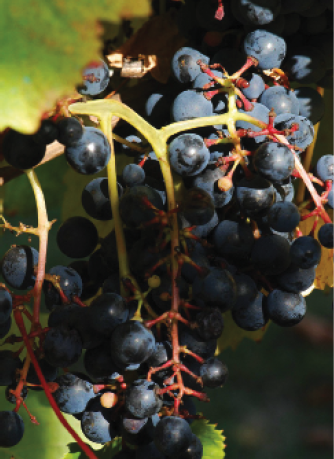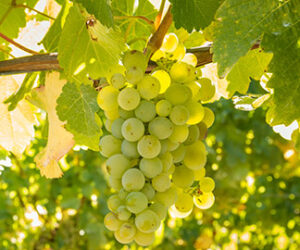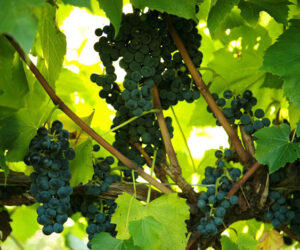 Want to live long? Drink wine . . . that’s my advice anyway. While keeping in perspective the idea of moderation and portion control; wine has long been associated with positive health benefits and increased life expectancy. However, the causal agents of these health benefits are still not really well known. Folks familiar with the Madiran region of southwest France may well know the tales of males living well into their nineties. Coincidence? It is generally accepted that diets rich in fruits and vegetables decrease your risk for cancer. On the other hand, there is a term known as the ‘French Paradox’, where meats, cheeses, and wine seem to have positive health benefits. Well, grapes are fruits, so that’s a plus. And grapes get made into wine, even better!
Want to live long? Drink wine . . . that’s my advice anyway. While keeping in perspective the idea of moderation and portion control; wine has long been associated with positive health benefits and increased life expectancy. However, the causal agents of these health benefits are still not really well known. Folks familiar with the Madiran region of southwest France may well know the tales of males living well into their nineties. Coincidence? It is generally accepted that diets rich in fruits and vegetables decrease your risk for cancer. On the other hand, there is a term known as the ‘French Paradox’, where meats, cheeses, and wine seem to have positive health benefits. Well, grapes are fruits, so that’s a plus. And grapes get made into wine, even better!
Modern scientists continue to focus on the phenolic compounds in grapes and wine as contributing to an antioxidant pool in your bloodstream that is able to react with free radicals and mutant cells to neutralize them. But back to the life expectancy issue in the Madiran region, and this is strictly speculative, some people say it’s because of the grape that is grown there. A deeply pigmented, high in phenolic-compounds grape called Tannat.
Tannat’s Upbringing
If you drew a line due south from Bordeaux, the Madiran region would be about halfway to the the Spanish border (in the Pyrenees Mountains), a region also known as the Hautes Pyrénées. The first records where this grape variety show up were in 1783 using the single ‘n’ version of Tanat. The modern version with two n’s, showed up in writings starting in 1827. According to Jancis Robinson, the name probably originates from one of the regional dialects, where ‘tanat’ means ‘colored like tan’, describing its deeply pigmented skins. Or it could be because of its high tannin content. The variety was not commercially bred, so there is only anecdotal evidence of its existence. The grape was probably the progeny of natural crosses between the endemic grape varieties of the region. Ampellographic grouping combines it with other local varieties: Courbu Blanc, Crouchen, Manseng Noir, and Petite Courbu. The most recent parentage analysis using twenty-two DNA-specific markers reveal a possible parent-offspring relationship between Tannat and Manseng Noir. This gets a little complicated, because it suggests a “which came first, the chicken or the egg” conundrum. Simply, there was a vine morphologically similar to Tannat initially that crossed naturally with Manseng Noir, the resultant seeds still produced a morphologically similar vine when they rooted and that is the Tannat we see today.
In addition to plantings in France, there are about 100 acres in Italy, about 250 acres in California, and a smattering of test trials in Virginia, Illinois, and Georgia. But it was in the South American country of Uruguay where Tannat really adapted to the local climate and soils. It currently fills out about 22% of the country’s total vineyard area. There, Tannat totals almost 4,500 acres (2009), some on its own roots, as the root louse Phylloxera is not a problem there. It was called ‘Harriague’ at first in honor of Pascal Harriague, who introduced it in 1870. Argentina, Brazil, and Peru follow Uruguay in total acreage.
Tannat Viticulture
The variety is known for its mid-season ripening and generally vigorous growth. The clusters are large, but produce small berries. The berries contain five seeds as opposed to three that is typical of other vinifera varieties. In the vineyard, using a pruning technique like cane pruning helps tame the growth, but can also lead to dense canopies which can promote bunch rot within the clusters. Trellising helps open up the canopy, and also provides light exposure to help develop the clusters. One common issue with cane pruning is that many clusters can wind up bunched tightly at the head of the vine, so some growers will thin the fruit to improve indirect sunlight exposure and promote air flow in the fruiting zone. A good viticulturist should be consulted if planting it.
Tannat Enology
Phenolics and tannins are what Tannat is known for. In Uruguay, the wines tend to be more approachable at younger ages, due to the climate and viticultural practices which expose the fruit and promote tannin development on the vine. Indirect sunlight via proper trellising, cropping levels, and a long growing season go a long way to develop this characteristic. But that is not the perfect solution for the other regions where Tannat is grown, even in its native region in France. The winemaker must then practice more gentle techniques to not overly pulverize the berries which can cause overt bitterness and astringency from excessive tannins. In all areas where Tannat is made, blending with other varieties to reduce tannin perception is common. The blends in the Madiran (40-60% Tannat) and Saint-Mont (60% Tannat) utilize Cabernet Sauvignon and Cabernet Franc as its principle blending partner. In Uruguay, it is sometimes blended with Pinot Noir and Merlot, but the best Tannat have an acid-tannin-alcohol balance, best left to age in the bottle. In Uruguay they often have more rounded tannins, and can be promoted as a single variety there.
Attaining a balanced wine with a grape that is known to have excess tannin–phenolic composition, starts in the vineyard. In the winery, to make a good wine, you need to balance the alcohol, tannins, and acidity. To balance alcohol, a reasonable sugar concentration at harvest of 24 °B will yield an alcohol of about 14.5%. The challenge with a harvest at that sugar concentration, is that the tannins in the berries on the vine may not be developed completely. So in warmer regions, growers will hang the fruit longer resulting in higher sugars and lower acidity, and higher alcohol by volume. If that is the case, an acidulation step using water should be carried out. But in regions where 24 °B is difficult to obtain, the acidity might be fine, so a gentler maceration technique is favored to reduce the phenolic extraction. Spacing your crusher rollers farther apart, using manual punch downs, and possibly pressing prior to dryness are ways to work this fruit. Pressing early decreases the time the wine is in contact with the seeds. The seeds are rich in the phenolics, catechin, and epicatechin, all of which can cause bitterness.
Seeds, via an extended maceration lead to more bitterness early in a wine’s life, taking more time to come together and soften during bottle aging. At pressing, regardless of the timing, keep your free run and press fractions separate for possible blending back to taste and texture later, or not. In the cellar, introduction of oxygen during barrel aging, topping and racking, or intentionally using a commercial process of micro-oxygenation (MOX), help soften the tannins for a more approachable wine.
The Grape Legend
In the region of France where Tannat is grown, it is reported to contain double the national average of men aged between ninety and ninety-nine. Is this the local Tannat variety at work? Well, Tannat contains high levels of procyanidins, which are reported to be the source of red wine’s health benefits. I participated in some research about 25 years ago, which pointed to certain polyphenolic compounds delaying tumor onset in our model. But in the end we only had a story to tell despite extensive investigations. We couldn’t pinpoint the real phenolic compound that was working, but looking at the winemaking practices that went into the project, we thought we were coming close. The variety we used was Sangiovese, which via the winemaking process, had some of the highest phenolic levels I had seen in wine. This wine was so bitter and astringent, it made your mouth pucker. It was a commercial wine and we found out later that it had undergone excessive seed contact. It is these small research projects that will help us focus in on why wine can be a healthy choice, regardless of the variety. Tannat is just a good example of local legend.
So if the polyphenols and tannins are so good for you, then why are we trying to limit their expression in the wine? I think it points to something we all need to take into perspective with winemaking and life in general: Everything in moderation. Or as my doctor likes to refer to it, portion control. Enjoy.
Tannat Recipe (5 gallons/19 L)
Ingredients
125 pounds (57 kg) fresh Tannat fruit
0.5 quart (0.5 L) distilled water
10% potassium metabisulfite (KMBS) solution. Weigh 10 grams of KMBS, dissolve into about 50 milliliters (mL) of distilled water. When completely dissolved, make up to 100 mL total with distilled water.
5 grams Lalvin EC-1118 yeast
5 grams Di-ammonium Phosphate (DAP)
5 grams Go-Ferm
5 grams Fermaid K (or equivalent yeast nutrient)
Tartaric acid
Malolactic fermentation starter culture (CHR Hansen or equivalent)
Other equipment or needs
15-gallon (57-L) food-grade plastic bucket for fermentation
5-gallon (19-L) carboy
(1 or 2) 1-gallon (4-L) jugs
Racking hoses
Destemmer/crusher
Wine press
Inert gas (nitrogen, argon or carbon dioxide)
Ability to maintain a fermentation temperature of 81–86 °F (27-30 °C)
Thermometer capable of measuring between 40–110 °F (4–43 °C) in one degree increments
Pipettes with the ability to add in
increments of 1 mL
Ability to measure residual sugar at the completion of fermentation
Step by step
1. Clean and sanitize all winemaking tools, supplies, and equipment.
2. Crush and destem the grapes. Transfer the must to your fermenter.
3. During the transfer, add 15 mL of 10% KMBS solution (This is the equivalent of 50 ppm SO2). Mix well.
4. Take a sample to test for Brix (°B), acidity and pH.
5. Layer the headspace with inert gas and keep covered. Keep in a cool place overnight.
6. The next day, sprinkle the Fermaid K directly to the must and mix well.
7. Go back to those lab results you took yesterday. Typical Brix for this style is 24-25 °B. Typical pre-fermentation acid levels will be 5 to 7 g/L in some warmer climates, possibly as low as 4 g/L. Adjust as necessary using tartaric acid to pre-fermentation level of 7.5 to 8 g/L. Don’t worry here; the malolactic conversion will drop the acid levels. We’ll measure later after fermentation. Slightly higher acid won’t hurt here.
8. Prepare yeast. Heat about 50 mL distilled water to 108 °F (42 °C). Mix the Go-Ferm into the water to make a suspension. Take the temperature. Pitch the yeast when the suspension is 104 °F (40 °C). Sprinkle the yeast on the surface and gently mix so that no clumps exist. Let sit for 15 minutes undisturbed. Measure the temperature of the yeast suspension and the must. You do not want to add the yeast to your cool juice if the difference in the temperature of the yeast and must exceeds 15 °F (8 °C). To avoid temperature shock, you should acclimate your yeast by taking about 10 mL of the must juice and adding it to the yeast suspension. Wait 15 minutes and measure the temperature again. Do this until you are within the specified temperature range.
9. When the yeast is ready, add it to the fermenter and mix.
10. You should see signs of fermentation within one to two days. This will appear as some foaming on the must surface, as though the berries are rising out of the medium.
11. Punch down should be done three times per day. Use a clean utensil or your hand to mix, making sure that the berries get completely immersed each time.
12. Monitor the Brix and temperature twice daily during peak fermentation (21 down to 10 °B). Morning and evening is best and more often if the temperature shows any indication of falling out of this range. If needed, warm or cool the must to keep in this range.
13. At about 16–19 °B, sprinkle in the DAP and punchdown.
14. Taste regularly through fermentation to determine if the tannins are extracting too quickly. If the astringency is high, you can consider pressing early if you have the color you wish to achieve.
15. If you haven’t pressed by the time the Brix reaches zero (about 5-7 days), transfer the must to press, and press dry. Keep the free run wine separate from the press portion for now. Be sure to label your vessels.
16. Transfer the wine to your carboys or 1-gallon (4-L) jugs. Your press fraction may only be a gallon or two (4 or 8 L). Make sure you do not have any headspace, then place airlock.
17. Inoculate with your malolactic bacteria. Check the manufacturer’s instructions on how to prepare and inoculate.
18. Monitor the malolactic fermentation (MLF) using a thin layer chromatography assay. When the MLF is complete, add 2 mL of fresh KMBS (10%) solution per gallon of wine. This is about a ~40 ppm addition.
20. Measure the pH and titratable acidity. You want a finished TA of about 6.5 g/L. The pH is secondary but should be around 3.7. Consider adding acid to adjust the pH and TA prior to settling, but taste the wine first to make sure it is not too tart. 21. After two weeks, test for SO2 and adjust it as necessary to attain 0.8 ppm molecular SO2. (There is a simple SO2 calculator at www.winemakermag.com/guide/sulfite). Check the SO2 in another two weeks and adjust. Once the free SO2 is adjusted, maintain at this level. You’ll just need to check every two months or so, and before racking.
23. Rack the wine clean twice over 6-8 months to clarify. Consider during this period using some oak chips to add oak flavors, but don’t overexpose the wine to the oak. One to two weeks, sometimes less is sufficient for this volume.
24. Once the wine is cleared, it is time to move it to the bottle. This would be about eight months after the completion of fermentation.
25. Make this fun by having a blending party to integrate the press fraction back into the free run. You may not need it all, use your judgment.
26. If all has gone well to this point, given the quantity made, it can probably be bottled without filtration. That said, maintain sanitary conditions while bottling. Once bottled, you’ll need to periodically check your work by opening a bottle to enjoy!





